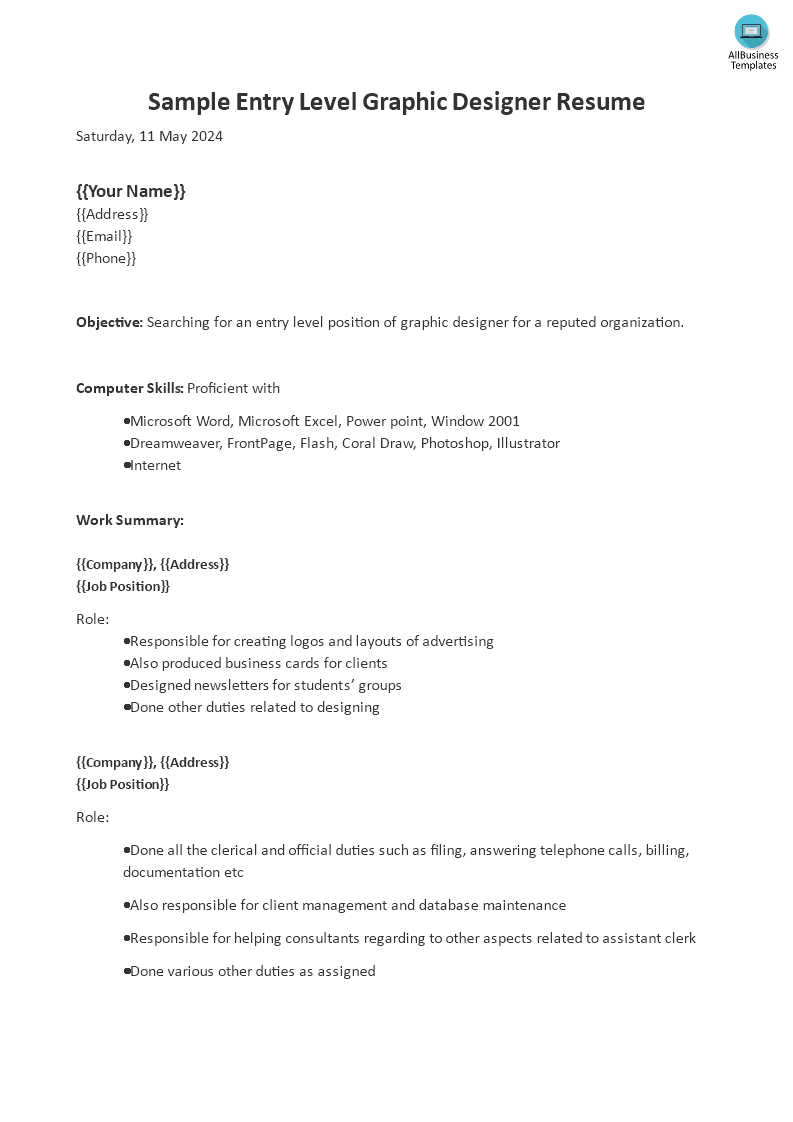Entry Level Designer Resume
Save, fill-In The Blanks, Print, Done!

Download Entry Level Designer Resume
Microsoft Word (.doc)Or select the format you want and we convert it for you for free:
- This Document Has Been Certified by a Professional
- 100% customizable
- This is a digital download (37 kB)
- Language: English
- We recommend downloading this file onto your computer.
How do you create a designer resume? Are you searching for an entry-level designer resume template? Our entry-level resume templates are designed with professional and modern styles to help you stand out from other applicants. Start creating a resume today and land your dream job.
A designer's resume is a document that showcases the skills, experience, and creativity of a professional in the field of design. Whether it's graphic design, web design, interior design, fashion design, or any other design discipline, the resume is a visual representation of the candidate's capabilities and accomplishments.
Here are some key elements typically found in a designer's resume:
- Contact Information: Name, address, phone number, and email address.
- Portfolio Link: Many designer resumes include a link to an online portfolio where employers can view samples of the candidate's work.
- Summary/Objective: A brief statement summarizing the designer's skills, experience, and career goals.
- Skills: Highlight key design skills such as proficiency in design software (e.g., Adobe Creative Suite), typography, color theory, layout design, illustration, etc.
- Education: List any relevant degrees, certifications, or courses related to design.
- Work Experience: Detail the designer's work history in reverse chronological order, including job titles, company names, dates of employment, and descriptions of projects worked on and achievements.
- Projects/Portfolio: Showcase selected projects or pieces of work that demonstrate the designer's abilities. This could include images, descriptions, and any relevant metrics (e.g., increased engagement, awards won, etc.).
- Awards and Recognition: Highlight any awards, honors, or recognition received for design work.
- Client Testimonials: If available, include testimonials or quotes from satisfied clients or colleagues.
- Software Proficiency: List specific design software tools and programs that the designer is proficient in.
- Optional Sections: Depending on the designer's experience and preferences, additional sections such as professional affiliations, volunteer work, languages spoken, or relevant interests can be included.
In addition to providing relevant information, a designer's resume should also be visually appealing and well-designed, reflecting the candidate's aesthetic sensibilities and attention to detail. It's essential to strike a balance between creativity and professionalism to make a memorable impression on potential employers.
DISCLAIMER
Nothing on this site shall be considered legal advice and no attorney-client relationship is established.
Leave a Reply. If you have any questions or remarks, feel free to post them below.
Related templates
Latest templates
Latest topics
- GDPR Compliance Templates
What You Need To Be DPR compliant? Are you looking for useful GDPR document templates to make you compliant? All these compliance documents will be available to download instantly... - Google Sheets Templates
How to work with Google Sheets templates? Where to download useful Google Sheets templates? Check out our samples here. - Drop Shipping Agreement
How to start drop shipping? Do you need a Drop shipping Agreement? Check out our Dropshipping Agreement templates now! - Excel Templates
Where to find usefl Excel templates? How do I create a template in Excel? Check these editable and printable Excel Templates and download them directly! - Google Docs Templates
How to create documents in Google Docs? We provide Google Docs compatible template and these are the reasons why it's useful to work with Google Docs...
cheese

